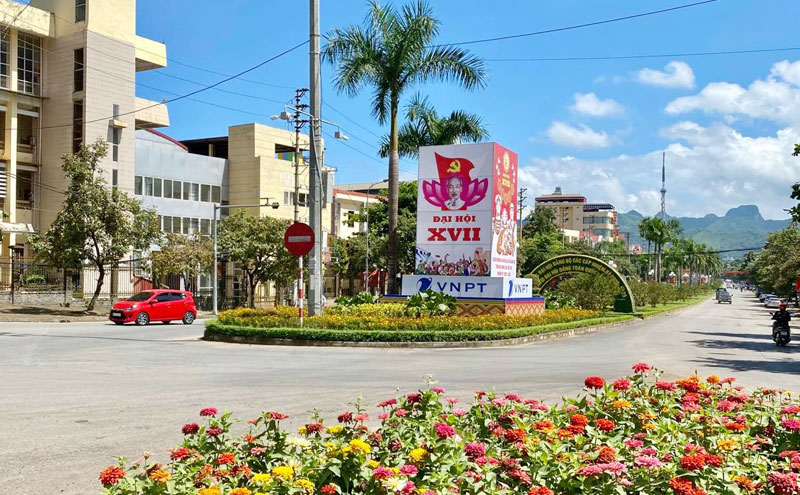
(HBO) – Preparations for the 17th Party Congress of Hoa Binh province for the 2020-2025 tenure have been actively made over the past few weeks, with communications activities and landscape improvement carried out.
 Tran Hung Dao street in Hoa Binh province colourfully
decorated in celebration of the 17th provincial Party Congress.
Tran Hung Dao street in Hoa Binh province colourfully
decorated in celebration of the 17th provincial Party Congress.
To date, all streets and roads in Hoa Binh city
have been adorned with flags and flowers. Hundreds of large billboards, flags,
posters and banners marking all-level Party congresses and the provincial Party
Congress have been erected. The messages celebrating Party congresses stand out
at public places like the province’s Cultural Palace, the T-junction of Ky Son
ward, the cross-road of Tan Thinh ward, the Hoa Binh Square intersection and
the T-junction of An Duong Vuong – Tran Hung Dao streets, so as to easily
access local residents.
The joyful atmosphere can be felt across the
city as the national flag is hung in all residential areas and local houses.
Besides, landscape improvement has been promoted
by the Hoa Binh Urban Environment JSC. All of the firm’s employees have been
mobilised to keep local streets green, clean and beautiful by increasing waste
collection, pruning trees, planting flowers, and installing more lamps at some
locations, from the expanded stretch of Chi Lang street, Tran Hung Dao street
to Truong Han Sieu street and Thinh Lang avenue./.
With an increasingly vibrant and widespread emulation movement aimed at building cultured residential areas and cultured families, Yen Thuy District has been making steady progress toward improving both the material and spiritual well-being of its people, while fostering a civilized, prosperous, beautiful, and progressive community.
Once lacking recreational spaces and community facilities, Residential Group 2 in Quynh Lam Ward (Hoa Binh City) has recently received attention for the construction of a new, spacious, and fully equipped cultural house. The project followed the model of state support combined with public contributions in both labor and funding.
The "All people unite to build cultural life" movement, which has been effectively integrated with Kim Boi district’s socio-economic development goals, is fostering a lively spirit of emulation across local residential areas, hamlets, villages, public agencies, and enterprises. In addition, through the initiative, traditional cultural values are being preserved and promoted, while community solidarity and mutual support in poverty reduction and economic development are being strengthened.
A working delegation of the Hoa Binh provincial People’s Committee led by its Permanent Vice Chairman Nguyen Van Toan on June 11 inspected the progress of a project to build the Mo Muong Cultural Heritage Conservation Space linked to tourism services in Hop Phong commune, Cao Phong district.
Born and growing in the heroic land of Muong Dong, Dinh Thi Kieu Dung, a resident in Bo town of Kim Boi district, in her childhood was nurtured by the sweet lullabies of her grandmother and mother. These melodies deeply imprinted on her soul, becoming an inseparable part of her love for her ethnic group's culture. For over 20 years, this love for her hometown has driven Dung to research, collect, and pass down the cultural values of the Muong people to future generations.
In the final days of May, the Ethnic Art Troupe of Hoa Binh Province organized performances to serve the people in remote, mountainous, and particularly disadvantaged areas within the province. These were not just ordinary artistic shows, but they were the meaningful journeys aimed at spreading cultural values, enhancing the spiritual life of the people and contributing to the preservation of ethnic minority cultural identities.



 Tran Hung Dao street in Hoa Binh province colourfully
decorated in celebration of the 17th provincial Party Congress.
Tran Hung Dao street in Hoa Binh province colourfully
decorated in celebration of the 17th provincial Party Congress.